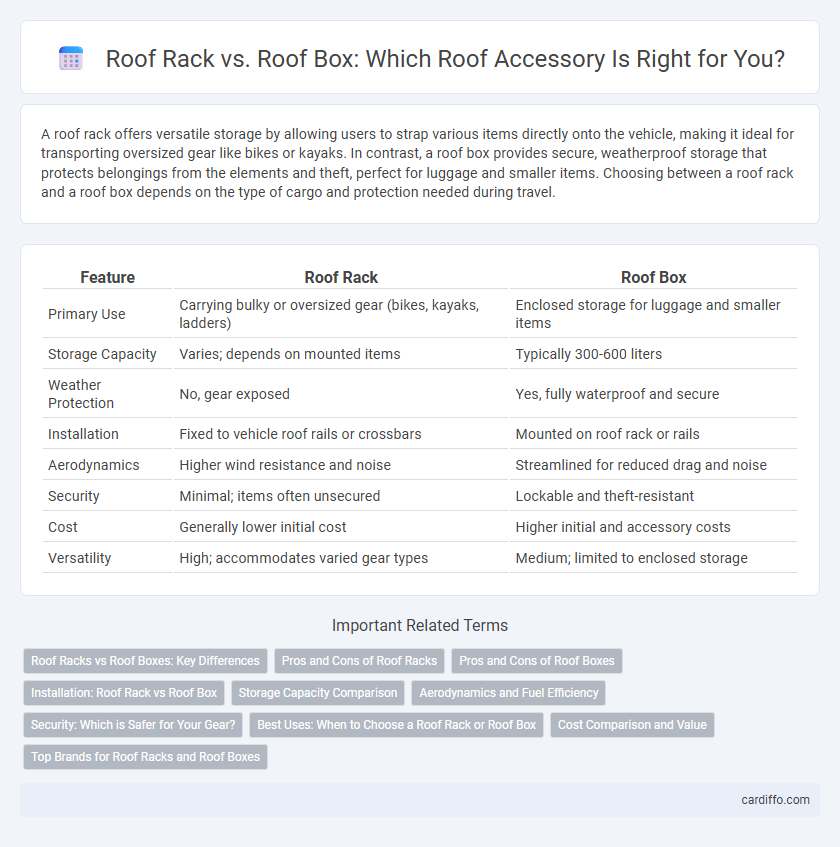A roof rack offers versatile storage by allowing users to strap various items directly onto the vehicle, making it ideal for transporting oversized gear like bikes or kayaks. In contrast, a roof box provides secure, weatherproof storage that protects belongings from the elements and theft, perfect for luggage and smaller items. Choosing between a roof rack and a roof box depends on the type of cargo and protection needed during travel.
Table of Comparison
| Feature | Roof Rack | Roof Box |
|---|---|---|
| Primary Use | Carrying bulky or oversized gear (bikes, kayaks, ladders) | Enclosed storage for luggage and smaller items |
| Storage Capacity | Varies; depends on mounted items | Typically 300-600 liters |
| Weather Protection | No, gear exposed | Yes, fully waterproof and secure |
| Installation | Fixed to vehicle roof rails or crossbars | Mounted on roof rack or rails |
| Aerodynamics | Higher wind resistance and noise | Streamlined for reduced drag and noise |
| Security | Minimal; items often unsecured | Lockable and theft-resistant |
| Cost | Generally lower initial cost | Higher initial and accessory costs |
| Versatility | High; accommodates varied gear types | Medium; limited to enclosed storage |
Roof Racks vs Roof Boxes: Key Differences
Roof racks provide an open, customizable platform for securing various items like bikes, kayaks, and luggage, offering flexibility for different cargo sizes and shapes. Roof boxes are enclosed storage containers that protect belongings from weather and theft, ideal for securely transporting smaller or fragile items. Choosing between roof racks and roof boxes depends on cargo type, security needs, and weather protection requirements.
Pros and Cons of Roof Racks
Roof racks provide versatile cargo-carrying capabilities, allowing users to transport bulky items like bicycles, kayaks, and construction materials with ease. Their open design offers flexibility and easier access but exposes cargo to weather conditions and potential theft. Installation and removal can be more straightforward compared to roof boxes, though aerodynamic drag may reduce fuel efficiency.
Pros and Cons of Roof Boxes
Roof boxes offer increased storage capacity with a streamlined design that minimizes wind resistance compared to traditional roof racks. Their weatherproof construction protects belongings from rain, snow, and dust, making them ideal for long trips. However, roof boxes can add significant weight to the vehicle's roof, potentially affecting fuel economy and handling, and may require removal when not in use due to their bulk.
Installation: Roof Rack vs Roof Box
Roof racks require a secure mounting system directly onto the vehicle's roof rails or fixed points, ensuring stability for various cargo types. Roof boxes attach to these racks with clamps or bolts, often requiring no additional tools for installation but need careful alignment for aerodynamic efficiency. Installation time for roof racks is generally longer due to their structural setup, whereas roof boxes offer quicker attachment once the rack is in place.
Storage Capacity Comparison
Roof boxes generally offer significantly larger storage capacity compared to roof racks, making them ideal for bulky items and extended trips. Roof racks provide flexible storage options by allowing users to attach various accessories, but their open frame limits the volume and protection of stored items. For maximizing cargo space and safeguarding belongings from weather, roof boxes outperform roof racks in overall storage efficiency.
Aerodynamics and Fuel Efficiency
Roof racks create increased air resistance due to their exposed design, which can negatively impact a vehicle's aerodynamics and reduce fuel efficiency. In contrast, roof boxes offer a streamlined shape that minimizes drag, helping maintain better fuel economy during travel. Choosing a roof box over a roof rack is ideal for enhancing aerodynamic performance and conserving fuel on long trips.
Security: Which is Safer for Your Gear?
Roof boxes provide enhanced security for your gear due to their lockable design, offering protection against theft and weather elements. Roof racks expose items to potential theft unless additional locking mechanisms or security accessories are used. Choosing a roof box ensures both safety and peace of mind when transporting valuable or sensitive equipment.
Best Uses: When to Choose a Roof Rack or Roof Box
Roof racks are ideal for transporting bulky items like bicycles, kayaks, or construction materials, providing versatility and easy access without covering the cargo. Roof boxes offer secure, weatherproof storage for luggage, camping gear, or skis, maximizing protection during long trips or in harsh weather conditions. Choose a roof rack for open, oversized loads and a roof box for organized, enclosed storage needs.
Cost Comparison and Value
Roof racks generally cost between $150 and $500, offering a versatile and durable solution for transporting various gear types without significantly impacting vehicle height. Roof boxes, priced from $400 to $1,200, provide secure, weatherproof storage with added aerodynamics, improving cargo protection but at a higher initial investment. Choosing between a roof rack and roof box depends on budget constraints and the value placed on cargo security, capacity, and ease of access during travel.
Top Brands for Roof Racks and Roof Boxes
Thule, Yakima, and Rhino-Rack are top brands renowned for durable roof racks, offering versatile mounting options for bikes, kayaks, and cargo carriers. For roof boxes, Thule, Yakima, and INNO lead the market with aerodynamic designs, high capacity storage, and weather-resistant materials ideal for road trips and outdoor adventures. Choosing between a roof rack and roof box depends on storage needs, with these brands providing premium solutions for secure, stylish, and functional rooftop cargo management.
Roof rack vs Roof box Infographic

 cardiffo.com
cardiffo.com